Jean Lambert-wild
| Jean Lambert-wild | |
|---|---|
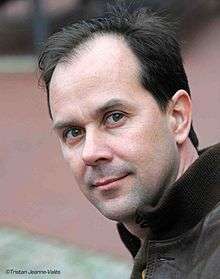 | |
| Born |
1972 (age 43–44) Réunion |
| Occupation | Theatre director, playwright, actor, scenographer |
| Nationality | French |
| Notable awards | 2014: Appointed Knight of the Ordre des Arts et des Lettres by the French Ministry of Culture and Communication |
Jean Lambert-wild is a theatre-maker and theatre director born in 1972 in Réunion. He is the artistic director of Theatre de l'Union – Centre Dramatique National du Limousin, and the director of L'Académie, Ecole Nationale Supérieure de Théâtre du Limousin.[1]
Biography
Early life
In 1979, his father, who was a livestock farmer, created the farming cooperative Sica Révia.[2] In 2012, the cooperative was composed of 323 livestock farmers. As a child, Jean Lambert-wild experienced the creation of this cooperative as an initiatory event, which mythology continues to influence several of his projects. At the time, all he dreamed of was “the sea, Conrad and pirates”.[3] After several extravagant attempts to escape the island during his adolescence, he eventually moved to mainland France in 1990. He settled in Lyon and started studying for a BA in Philosophy at Lyon III University. It is there that André Arcellaschi, his Latin lecturer, incited him to direct plays by Plautus, Seneca the Younger and Gombrowicz.[3] He considered joining the Merchant Navy, but shortly before saw a production of Chekhov’s Three Sisters by German director Matthias Langhoff. This production had a strong impact on Lambert-wild, who realised that theatre was the medium that would give him the freedom he had been looking for.[4]
Artistic life until 2006
Lambert-wild learned his craft assisting several different theatre directors. First, Michel Dubois, who, having found an interest in Lambert-wild’s writings, invited him to work at La Comédie de Caen. From the role of apprentice, he moved on to become assistant director, thus progressively acquiring the basic tenets of his theatrical vocabulary. He then became the assistant of Jean-Yves Lazennec, Philippe Goyard and more prominently Matthias Langhoff, whom he assisted for several years.[5]
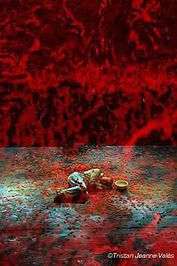
In 1990, he wrote and directed Grande Lessive de Printemps (Great Spring Clean), which premiered at Espace 44 in Lyon.[6] This was the beginning of his Hypogeum, a complex body of work that Lambert-wild constructs over the course of his lifetime.
The Hypogeum is composed of three Confessions, three Threnodies, three Epics, two Exclusions, one Dithyramb and 326 “Calentures”.
Over the years, Lambert-wild has created a fantasised autobiography that nurtures his work for the stage. This is recurrently present in the Ecmnesia and the Calentures.
The Ecmnesia is composed of the Confessions, the Threnodies and the Epics of the Hypogeum, along with other large-scale projects that aren’t included in the Hypogeum.
The Calentures are shorter performances, ranging from 15 to 45 minutes in length. They are created for specific occasions and are often site-specific (for festivals, in contemporary art centres, outdoors, in a public swimming-pool…). These performances usually question the notion of space in theatre. Both illusion and magic are preponderant in the Calentures. Jean Lambert-wild sees the Calentures as bouts of poetic fury, farcical at times, and at times tragic, that his striped pyjamas-wearing clown character experiences.[7]
To this day, twenty Calentures (see List of Calentures), 2 Confessions (Grande Lessive de Printemps (Great Spring Clean) in 1990 and Crise de nerfs – Parlez-moi d’amour (Fits of Hysterics – Tell Me About Love) in 2003), 2 Threnodies (Mue Sloughing) in 2005 and La Mort d’Adam (Death of Adam) in 2010, and 1 Epic (Splendeur et Lassitude du Capitaine Marion Déperrier (Splendour and Lassitude of Captain Marion Deperrier) in 1999) have been realised.
In 1997, he met Henri Taquet, then director of Le Granit – Scène Nationale de Belfort. This encounter gave Lambert-wild a chance to direct his first professional theatre productions. He moved to Belfort, and found this new environment conclusive to his artistic development. The same year, he entered into a partnership with his wife Catherine Lefeuvre, with whom he has two children,[8] composer Jean-Luc Therminarias, lighting designer Renaud Lagier, sound technician Christophe Farion, scenographer Thierry Varenne, and production manager and lighting designer Franck Besson. Together, they formed the Coopérative 326.[9] This was the first attempt in France to join together artists and technical professionals into a partnership based on cooperation, solidarity and the pooling of resources. What emerged was a participative and united network of artists, technicians, academics and entrepreneurs. Based in Belfort, La Coopérative 326 was met with great success, and its reputation spread to the rest of France. The shows authored by the Coopérative 326 were performed at prestigious institutions such as Théâtre de la Colline, Théâtre de l'Odéon, à la MC93 Bobigny or Festival d'Avignon.
Between 1997 and 2006, the Coopérative 326 provided an opportunity for Lambert-wild to develop his work as a writer, especially through his collaboration with François Berreur, director of publishing company Les Solitaires Intempestifs. Together, they started publishing several of Lambert-wild’s texts. In addition, his long association with Le Granit – Scène Nationale de Belfort, allowed him to develop a strong relationship with local audiences. This furthered his taste for theatre that is accessible and popular, challenging and groundbreaking. His theatrical experiments, supported by Le Granit, were well received by audiences who became loyal to his work. He explored different performance formats (large and small-scale, performances devised for private homes, Calentures etc.…) whilst also staging his own writing or the work of authors he admires, such as Pasolini or Kafka… During this period, he led several workshops, thus acquiring a solid experience as a facilitator of non-professional theatre. With composer Jean-Luc Therminarias, he created the label 326 Music and released several albums (see Discography). Being a part of Coopérative 326 also meant his theatre work could be shared and opened up to collaborators: “the theatre he believes in is, in essence, a practice that is multi “medium”. Theatre is where the codes of every artistic discipline can be expressed, where these codes create meaning. This is why, for each project he initiates, Lambert-wild puts together a phalanstery of collaborators, placing at the heart of his practice the combination of artistic, technical, scientific and academic competences, with an aim to explore new perspectives for theatre-making and writing.”

New responsibilities
In 2007, he was appointed director of Comédie de Caen – Centre Dramatique National de Normandie by the French Ministry of Culture, a role he retained until 31 December 2014.[10]
The Comédie de Caen’s mission involves enabling the creation and production of new work, and several of the shows it produces go on to tour nationally and internationally. As part of its mission, the institution also supports independent French and foreign theatre companies. The location of the Comédie de Caen, in the Normandy region, allowed Lambert-wild to further his efforts in developing non-Parisian audiences, in an attempt to make culture more accessible.
Since 1 January 2015, he is the director of Théâtre de l’Union, Centre Dramatique National du Limousin and of L’Académie, École Nationale Supérieure de Théâtre du Limousin, appointed by the French Ministry of Culture.[1]
Characteristics of Lambert-wild’s work
Lambert-wild uses the work of classic and contemporary authors to question contemporary theatrical creation. In each case, performers are central to these projects, and their function is to interrogate all aspects of the modernity that currently makes up performative practices. Lambert-wild often collaborates with artists who work in other disciplines: he explores the language of graphic novels with illustrator and multi-media artist Stéphane Blanquet, contemporary dance with choreographer Carolyn Carlson, contemporary art with visual artist Alexander Ponomarev, circus with the juggler Jérôme Thomas, cinema with film-maker François Royet, illusion with magicians Thierry Collet and Marc-Antoine Coucke and new media with computer engineer Emmanuel Maâ Berriet.[11]
International collaborations
His Creole origins and his numerous trips to Europe, Africa, North and South America and Asia are at the heart of several of his projects (whether through residencies, work in progress showings, performances in festivals and theatres in Norway, Hungary, Denmark, Italy, Germany, Belgium, Switzerland, the USA, Canada, Brasil, South Korea, Japan, China…).
Lambert-wild also regularly collaborates with international artists such as the artist Silke Mansholt (Germany), performer Jeremiah McDonald (USA), singer David Moss (USA), actor Jacqueline Humbert (USA), dancer and choreographer Juha Marsalo (Finland), choreographer Carolyn Carlson (USA/Finland), Russian dancers Elena and Olga Budaeva, actor Keita Mishima (Japan), theatre director Lorenzo Malaguerra (Switzerland).
He has developed a strong and lasting relationship with the African continent, working regularly with Burkinabe actor Odile Sankara (together they created nomadic performances that toured in France and in ten different African countries), and supporting African artists such as Ivorian actor and theatre director Fargass Assandé or Michel Bohiri.
Since 2012, he has been commissioned to write or direct work for the permanent companies of several National Theatres around the globe. He created L’Armoire du diable (The Devil’s Wardrobe) (2013) for the National Theatre of Hungary, in Budapest,[12] and Splendeur et lassitude du Capitaine Iwatami Izumi (2013) (Splendour and Lassitude of Captain Iwatami Izumi), an adaptation of his play Splendeur et Lassitude du Capitaine Marion Déperrier (Splendour and Lassitude of Captain Marion Deperrier) for the Shizuoka Performing Art Center (SPAC) in Shizuoka, Japan.[13]
Teaching and legacy
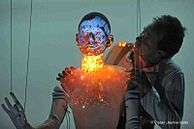
For Jean Lambert-wild, training and the act of handing over knowledge enable a collective engagement towards a common future. His taste for pedagogy and actor training leads him to regularly teach as a guest lecturer in regional Conservatoires in France. He is also a visiting lecturer at universities and arts schools in France and abroad (Sorbonne – Paris IV; UTC Université de Technologie de Compiègne; UTBM of Belfort-Montbéliard, the ENSATT – École Nationale des Arts et Techniques du Théâtre, Lyon; in the Arts Department of the University of Texas in Austin; CalArts University - The Center for New Performance in Los Angeles, California Institute of the Arts; Iamas University of Technology, Tokyo; the Maison des Artistes of Baguida, Togo[14]…). In 2013, he chaired the examining board at Institut supérieur des arts de Toulouse. Jean Lambert-wild is also regularly invited to speak at talks and conferences and to contribute to academic publications. Since September 2014, he is a Visiting Lecturer at Sciences Po – Paris teaching on the theme “Fury and Carnage in Western Theatre”.[1] Since 1 January 2015, Jean Lambert-wild is the director of the Académie de l’Union – École Nationale Supérieure Professionnelle de Théâtre du Limousin.[15] The Académie is one of 12 national Écoles Supérieures d’Art Dramatique, higher education centres for dramatic art. Under the direction of the Ministère de la Culture et de la Communication (Ministry of Culture and Communication) these Écoles Supérieures deliver a higher education degree for professional actors: the Diplôme National Supérieur Professionnel de Comédien. The Académie is located at Saint-Priest-Taurion, 15 km from Limoges, in an environment that facilitates focused and intense training. The Académie cultivates an international dimension, with, among other things, partnerships and exchange programmes between the Académie and conservatoires or national theatre schools in Russia, Canada, Georgia and Japan. This international dimension will be solidified in the future by cooperation programmes developed with French-speaking countries.[16]
Jean Lambert-wild sees the Académie de l’Union as the breeding ground for Théâtre de l’Union, but also as the future of theatrical creation and a place for future expressions of collective freedom. The training offered at the Académie is plural and demanding, focusing on acting, on different approaches for voice and movement work, on exploring multiple creative languages, on the actor’s inventive potential, and on developing principles of autonomy with the aim of enabling individual participation within a collaborative and cooperative creative process. Working closely with Théâtre de l’Union – Centre Dramatique National du Limousin, the course offered by the Académie is developed through intensive internships, participation in performances directed by external contributors, and, as soon as from the second year, the students’ own projects. This course makes the Académie a real hive of creativity. The next rounds of auditions for admission will take place in 2016 in Dijon, Orléans and Limoges.[17]
As a director and scenographer
Ecmnesia
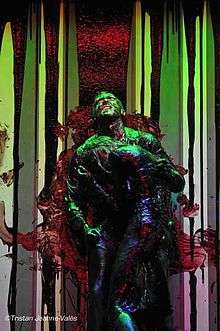
- 1990 : Grande lessive de printemps - Première Confession de l'Hypogée (Great Spring Clean – First Confession of the Hypogeum), a show by Jean Lambert-wild, Espace 44 in Lyon.
- 1992 :1992 : La Naissance de la paix (The Birth of Peace) by René Descartes, a show by Jean Lambert-wild and Groupe 3, Lyon 3 University.
- 1992 : Yvonne, princesse de Bourgogne (Ivonia, Princess of Burgundia) by Witold Gombrowicz, a show by Jean Lambert-wild and Groupe 3 Lyon 3 University.
- 1993 :1993 : Les Bacchides (Bacchides) by Plautus, a show by Jean Lambert-wild and Groupe 3, Lyon 3 University.
- 1994 : Les Troyennes (Trojan Women) by Seneca the Young, a show by Jean Lambert-wild and Groupe 3, Lyon 3 University.
- 1997 : 1997 : Aquarium (Fish Tank), based on Olly’s Prison (Maison d'arrêt) by Edward Bond, a show by Jean Lambert-wild, Café de l'Harmonie, Lyon.
- 1997 : V versus w, a show by Jean Lambert-wild, Café de l'Harmonie, Lyon.
- 1998 : Paradis (Paradise), a show by Jean Lambert-wild, Café de l'Harmonie, Lyon.
- 1999 : Splendeur et lassitude du Capitaine Marion Déperrier, Épopée en deux Époques et une Rupture (Splendor and Lassitude of Captain Marion Deperrier, Epic in two periods and a break), written by Jean Lambert-wild, Le Granit - Scène Nationale de Belfort.
- 2001 : Orgia by Pier Paolo Pasolini, a show by Jean Lambert-wild and Jean-Luc Therminarias, Théâtre National de la Colline, Paris.
- 2001 : Le Terrier (Der Bau), by Franz Kafka, a show by Jean Lambert-wild, Le Granit, scène Nationale de Belfort.
- 2002 : Spaghetti's Club, a show by Jean Lambert-wild and Jean-Luc Therminarias, created at La Filature, Scène Nationale de Mulhouse. Performed at MC93 in Bobigny, following work in progress showings in Bulgaria and Berlin.
- 2003 : Crise de nerfs - Parlez-moi d'amour, Deuxième Confession de l'Hypogée (Fits of Hysterics – Tell Me About Love, Second Confession of the Hypogeum), a show by Jean Lambert-wild and Jean-Luc Therminarias, Avignon Festival, 2003.
- 2005 : Mue, Un discours de Sereburã, accompagné d'un rêve de Waëhipo Junior et des mythes de la communauté Xavante d'Etênhiritipa, Première Mélopée de l'Hypogée, (Sloughing, A Speech by Sereburã with a dream by Waëhipo Junior and the myths of the Xavante community from Etênhiritipa, First Threnody of the Hypogeum), a show by Jean Lambert-wild and Jean-Luc Therminarias, created at the Castle of Saumane, as part of the Avignon Festival 2005.
- 2005 : Nous verrons bien (We’ll See), a show by Jean Lambert-wild, Contre-Courant Festival, Avignon.
- 2006 : Sade Songs, A tale by Jean-Rémy Guédon, Stéphane Blanquet and Jean Lambert-wild, Allan, Scène Nationale de Montbéliard.
- 2007 : A corps perdu (Heart and Soul), and Arrêt sur Image (Freeze Frame), two shows by Jean Lambert-wild, Petit-Colombier, Comédie Française, followed by a tour in West Africa.
- 2008 : Le Malheur de Job (Job’s Misfortune), a show by Jean Lambert-wild, Jean-Luc Therminarias, Dgiz, Jérôme Thomas and Martin Schwietzkze, Comédie de Caen - Centre Dramatique National de Normandie.
- 2009 : Ro-Oua ou le peuple des rois (Ro-oua, or The People of the Kings), a show by Jean Lambert-wild, Contre-Courant Festival, Avignon.
- 2009 : Le Recours aux forêts (The Retreat to the Forests), a show by Jean Lambert-wild, Jean-Luc Therminarias, Michel Onfray, Carolyn Carlson and François Royet, Comédie de Caen - Centre Dramatique National de Normandie as part of Les Boréales Festival, * 2009.
- 2010 : Comment ai-je pu tenir là-dedans ? (How Was I Ever Able To Live In there?), based on La Chèvre de Monsieur Seguin (The Goat of Monsieur Seguin) by Alphonse Daudet, a tale by Stéphane Blanquet and Jean Lambert-wild, Comédie de Caen - Centre Dramatique National de Normandie. Nominated for the Molière Awards 2010, in the category “Jeune Public” (Family Entertainment).
- 2010 : La Mort d'Adam - Deuxième Mélopée de l'Hypogée, (The Death of Adam – Second Threnody of the Hypogeum), a show by Jean Lambert-wild, Jean-Luc Therminarias, François Royet and Thierry Collet, Avignon Festival, 2010.
- 2011 : L'Ombelle du Trépassé (The Deceased’s Umbel), a show by Jean Lambert-wild and Yann-Fañch Kemener, Maison de la Poésie, Paris.
- 2011 : Nazarov le Trimardeur - Le miel, (Nazarov le Trimardeur – Honey) a show by Jean Lambert-wild and Stéphane Pelliccia, Comédie de Caen - Centre Dramatique National de Normandie.
- 2012 : War Sweet War, a show by Jean Lambert-wild, Jean-Luc Therminarias, Stéphane Blanquet and Juha Marsalo, Comédie de Caen - Centre Dramatique National de Normandie.
- 2012 : La Sagesse des abeilles, Première leçon de Démocrite, (The Wisdom of Bees, The First Lesson of Democritus ), a show by Jean Lambert-wild, Jean-Luc Therminarias, Michel Onfray, Lorenzo Malaguerra and François Royet, Comédie de Caen - Centre Dramatique National de Normandie.
- 2012 : Mon amoureux noueux pommier, (My Lover Gnarled Apple Tree), a tale by Jean Lambert-wild and Stéphane Blanquet, Théâtre national de Chaillot.
- 2013 : L'armoire du Diable (The Devil’s Wardrobe), a show by Jean Lambert-wild, created with the permanent company of the National Theatre of Hungary in Budapest (Hungary).
- 2013 : Nazarov le trimardeur - Mon œuf, (Nazarov le Trimardeur – My Egg) a show by Jean Lambert-wild and Stéphane Pelliccia, Comédie de Caen - Centre Dramatique National de Normandie.
- 2014 : En attendant Godot, (Waiting for Godot) by Samuel Beckett, directed by Jean Lambert-wild, Marcel Bozonnet and Lorenzo Malaguerra, Comédie de Caen.
- 2014 : Splendeur et Lassitude du Capitaine Iwatani Izumi, (Splendor and Lassitude of Captain Iwatani Izumi), a show by Jean Lambert-wild, Keita Mishima and Akihito Hirano, Shizuoka Performing Arts Center, Shizuoka (Japan).
- 2015 : Richard III - Loyaulté Me Lie, based on Richard III by William Shakespeare, a show by Jean Lambert-wild, Lorenzo Malaguerra, Stéphane Blanquet, Élodie Bordas and Jean-Luc Therminarias, co-production Autumn 2015, in France / Switzerland / Belgium / USA / Quebec [18] · .[19]
- 2016 : Roberto Zucco, de Bernard-Marie Koltès, spectacle de Jean Lambert-wild et Lorenzo Malaguerra, création prévue au Myeongdong Theater, Séoul (Corée) le 23 septembre 2016
Calentures
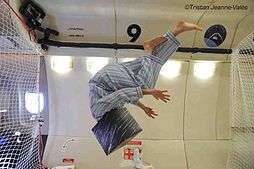
- Ægri Somnia, Calenture No.2 of the Hypogeum, created for the Georges Rigal public swimming-pool, Paris. Collaboration with Théâtre National de la Colline, 2002.
- Mon corps à la patrie, tes cendres au Panthéon, (My Body to the Homeland, Your Ashes to the Pantheon) Calenture No.3 of the Hypogeum, Avignon Festival, 2004.
- Aphtes (Mouth Ulcers), Calenture No.4 of the Hypogeum, Espace Gantner de Bourognes (Territoire de Belfort), 2000.
- My story is not a loft, Calenture No.17 of the Hypogeum, Avignon Festival, 2005.
- Mon Savoureux (You, Delicious), Calenture No.20 of the Hypogeum, Le Granit, Scène Nationale de Belfort, 2006.
- Le Mur (The Wall), Calenture No.27 of the Hypogeum, IRCAM – Paris, 2002.
- Dédicace (Book Signing), Calenture No.29 of the Hypogeum, La Chartreuse, Avignon Festival, 2002.
- Faites-le taire! (Shut Him Up!), Calenture No.41 of the Hypogeum, Festival des Escales Improbables, Montreal, Canada, 2006.
- Petites peaux de confiture (Little Jars, A Skin of Jam), Calenture No. 47 of the Hypogeum, Usine C, Montréal, 2012.
- Le labyrinthe du Cicérone (The Cicerone’s Labyrinth), Calenture No.59 of the Hypogeum, Hôtel de Soubise, Paris, in collaboration with visual artist Milene Guermont, 2012.
- Comme disait mon père (Like My Father Used To Say), Calenture No.65 of the Hypogeum, published by Les Solitaires Intempestifs, 2009.
- Ma mère ne disait rien (My Mother Never Said Anything), Calenture No.66 of the Hypogeum, published by Les Solitaires Intempestifs, 2009.
- Éjaculation (Ejaculation), Calenture No.69 of the Hypogeum, Belfort, 2004.
- L'arbre à pyjamas (The Pyjama Tree), Calenture No.76 of the Hypogeum, Domaine d'Ô, Montpellier, 2012.
- Tête à tête (Tête-à-Tête), Calenture No.88 of the Hypogeum, Le Granit-Scène Nationale de Belfort, in collaboration with UTBM, 2003.
- In Blood we trust, Calenture No.97 of the Hypogeum, Avignon Festival, 2010.
- Space out space, zero gravity flight, Calenture No.113 of the Hypogeum, created with the CNES, Bordeaux-Mérignac Airport, 2013.
- Remember and don't forget to play, Calenture No.145 of the Hypogeum, Festival des Escales Improbables, Montreal, 2006.
- Noyade (Drowning), Calenture No.201 of the Hypogeum, Festival des Escales Improbables, Montreal, 2006.
- Le temps perdu (Lost Time), Calenture No.256 of the Hypogeum, Comédie de Caen, 2012.
- Chantons sous la mort (Singing In Death), Calenture No.325 of the Hypogeum, Festival des Escales Improbables, Montreal, 2006.
As a scenographer
Jean Lambert-wild did the scenography for all his works for the stage, both the Ecmnésie and the Calentures, but he also worked as a scenographer on the following projects :
- 1997 : Vater Land, Vater Land, by Jean-Paul Wenzel, a show by Philippe Goyard, Le Granit, Scène Nationale de Belfort.[20]
- 1998 : Combat de Nègres et de Chiens (Black Battles With Dogs), by Bernard-Marie Koltès, a show by Philippe Goyard, Le Granit, Scène Nationale de Belfort.[20]
- 2014 : Babel, After the war by Xavier Dayer and Alberto Manguel, a show by Lorenzo Malaguerra, Théâtre de Vevey.[21]
As an actor
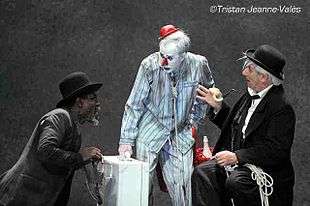
Since 1997, he has performed in each of the Calentures (see list of the Calentures), but he also play as an actor on the followings projects :
- 1992 : In Yvonne, princesse de Bourgogne (Ivona, Princess of Burgundia), by Witold Gombrowicz, which he also directed, Groupe 3, Theatre Society of Lyon III University.
- 1993 : In Les Troyennes (Trojan Women) by Seneca the Young, which he also directed, Groupe 3, Theatre Society of Lyon III University.
- 1996 : In L'île du salut (The Salvation Island), based on La colonie pénitentiaire (In The Penal Colony) by Franz Kafka, directed by Matthias Langhoff, Théâtre National de Bretagne, Rennes.
- 1997 : In V versus W, l’Impossible retour (The Impossible Return) et Migraine (Migraine), based on his own writings. Created with his first theatre company, L’écharpe rouge, based in Lyon.
- 2010 : In La Mort d’Adam (The Death of Adam) written and directed by Jean Lambert-wild, premiere at the Avignon Festival.
- 2014 : He plays the role of Lucky in En attendant Godot (Waiting for Godot) by Samuel Beckett, a show by Jean Lambert-wild, Marcel Bozonnet and Lorenzo Malaguerra.
- In 2016, he will play Richard III in his adaptation of Shakespeare’s eponymous play, Richard III - Loyaulté Me Lie, based on Richard III by William Shakespeare.
Published work
- 1998 : Splendeur et lassitude du Capitaine Marion Déperrier, published by Les Solitaires Intempestifs (ISBN 978-2-912464-39-2)
- 2003 : Crise de nerfs - Parlez-moi d'amour suivi de Ægri Somnia, published by Les Solitaires Intempestifs (ISBN 978-2-84681-054-8)
- 2005 : Mue - Première Mélopée - Un discours de Sereburã accompagné d'un rêve de Waëhipo Junior et des mythes de la Communauté Xavante d'Etênhiritipa, published by Les Solitaires Intempestifs (ISBN 978-2-84681-147-7)
- 2005 : Se Tenir Debout, Entretiens avec Mari-Mai Corbel, published by Les Solitaires Intempestifs (ISBN 978-2-84681-148-4)
- 2009 : Spectres de Printemps, Collection Nervium, (Comédie de Caen - Centre Dramatique National de Normandie)
- 2009 : Demain le Théâtre: songes épars dans l'attente, published by Les Solitaires Intempestifs (ISBN 978-2-84681-264-1)
- 2009 : Comme disait mon père, suivi de Ma mère ne disait rien, Calentures no 65 et no 66, published by Les Solitaires Intempestifs (ISBN 978-2-84681-265-8)
- 2009 : Le théâtre comme lieu où raconter l'Espace, in Espace(s), CNES, published by l'Observatoire de l'Espace (ISBN 978-2-85440-014-4)
- 2010 : La Mort d'Adam - Deuxième Mélopée (book + DVD) published by Les Solitaires Intempestifs (ISBN 978-2-84681-290-0)
- 2011: L'Ombelle du Trépassé (Accompagné de chants Bretons recueillis par Yann-Fanch Kemener) published by Les Solitaires Intempestifs (ISBN 978-2-84681-3396)
- 2012 : Ghost dance - Collection Nervium (Comédie de Caen - Centre Dramatique National de Normandie)
- 2012 : Addresse à l'ami, in Le Manifeste Hédoniste, published by Michel Onfray’s Autrement (ISBN 2746716127)
- 2012 : Ghost Dance - Remugles épars dans l'attente, and L’œil que je suis, in Frictions No.2021
- 2012 : L'Ombelle du Trépassé (book + CD) published by Les Solitaires Intempestifs (ISBN 978-2-84681-381-5)
- 2013 : Tout allait mieux autrefois, même l'avenir, in Frictions No.2122
- 2014 : Space Out Space, in Espace(s), CNES, Éditions de L'Observatoire de l'Espace (ISBN 9782854400274)
- 2014 : Déclaration de guerre, in Ces cris gravés, Éditions du Chameau (ISBN 978-2-917437-52-0)
- 2015 : Aux frontières du Royaume, in Frictions No.24 23
- 2015 : L'Armoire du diable, Une fable librement inspirée de contes tziganes, published by Les Solitaires Intempestifs, (ISBN 9782846814423)
- 2015 : La stratégie de la bicyclette, préface de la revue Frictions "Critique dramatique et alentours" rédigée par Jean-Pierre Han [22]
- 2015 : A poetic experience of the world, dans la revue "Imagine 2020 - art and climat change - There is Nothing" rédigée par Claudia Galhos aux éditions Art in site. (ISBN 978-989-95397-6-1) [23]
- 2016 : Richard III - Loyaulté me lie, suivi d'un essai de Raymond Geuss : Richard III, déchirement tragique et rêve de perfection. aux éditions Les Solitaires Intempestifs (ISBN 978-2-84681-472-0)
- 2016 : Discours d'Alexandrie, Revue Frictions n°26 - Printemps 2016
Discography
- Drumlike in salty bathtub - 326 Music CD326001
- Spaghetti's Club - "Le point de vue de Lewis Caroll" - 326 Music CD326005
- Spaghetti's Club - "La Conclusion" - 326 Music CD326009
- L'Ombelle du Trépassé - 326 Music CD326013
- Mon Amoureux noueux pommier - 326 Music CD 326014
Awards and nominations
- 1996 : Awarded an “Aide à l'écriture dramatique” grant (Grant for Playwriting), by the French Ministry of Culture, for Splendeur et Lassitude du Capitaine Marion Déperrier.
- 2000 : Awarded a “Villa Médicis Hors les Murs” grant (USA) to research and write Spaghetti's Club - "Le point de vue de John Cage" (Spaghettis’ Club – “John Cage’s Point of View”.
- 2009 ; CNL’s writers grant to write Tête perdue au fond de l'Océan - Première Mélopée (A Head Lost At The Bottom Of The Sea – First Threnody).
- 2010 : Nominated for a Molière Award, in the category “Jeune Public” (Family Entertainment), with the show Comment ai-je pu tenir là dedans (How Was I Ever Able to Live In There?), based on La Chèvre de Mr Seguin (The Goat of Monsieur Seguin) by Alphonse Daudet24
- 2014 : Appointed Knight of the Ordre des Arts et des Lettres by the French Ministry of Culture and Communication[24]
Further reading
- Phenomena, Cahiers de l’Espace, Espace Gantner 1999 / (ISBN 2-915151-02-4)
- Jean Lambert-wild – La scénographie high-tech, par Anne-Marie Lercher, revue L’Œil n°|533, février 2002 [25]
- Le Théâtre ? Une coopérative d’artistes par Lucille Garbagnati, revue Coulisses n°|25, janvier 2002 [26]
- Al Dente par Hervé Pons, revue Mouvements n° 24, novembre 2002 [27]
- Anges et chimères du virtuel par Corinne Pencenat, revue d’études esthétiques, 2002 / (ISBN 2-908930-82-X)
- Vers un théâtre des interfaces par Otto Sholtz, revue d’études esthétiques, 2002 / (ISBN 2-908930-82-X)
- Le théâtre comme art de la dépossession par Jean-Yves Lazennec, revue d’études théâtrales, Revue Registres n°8 2004 /(ISBN 2-87854-296-7 )
- L’art numérique par Edmond Couchot et Norbert Hilaire, Éditions Flammarion 2003 (p. 104- 105) / (ISBN 2081225123)
- Le réel, paradis perdu, par Mari-Mai Corbel, revue Mouvement n°20, mars-avril 2004 [28]
- Autour de Jacques Polieri : Scénographie et technologie, par Michel Corvin et Franck Ancel, Éditions de la BNF 2004 /(ISBN 2-7177-2296-3)
- Énergie du Grotesque – Crise de nerfs – Parlez-moi d’amour par Mari-Mai Corbel, revue Coulisses, n°30, mai 2004 /(ISBN 978-2-84867-064-5)
- Jean Lambert-wild par Chantal Boiron, Revue UBU – Scènes d’Europe n°|32, juillet 2004 [29]
- Un théâtre d’auteur – L’univers de Jean Lambert-wild par Corinne Pencenat, Théâtre Public n°174, juillet-septembre 2004 [30]
- Œuvres à plusieurs, par Richard Conte, revue Plastik Automne 2004 / (ISBN 2-85944-518-8)
- Environnements virtuels et nouvelles stratégies actantielles par Valérie Morignat, in Études théâtrales (n°|30) /2004 - Arts de la scène, scène des arts. Vol. III / (ISBN 2-930416-18-1)
- Formes hybrides : vers de nouvelles identités, textes réunis par Luc Boucris et Marcel Freydefont, avec la collaboration d’Anne Wibo. Actes du colloque des 4 et 5 décembre 2003, organisé par le Centre d’études du XXe de l’Université Paul-Valéry (Montpellier III). Publication : École d’architecture de Nantes - Centre d’études théâtrales de Louvain / (ISBN 2-930416-18-1)
- Une techno-poétique par Mari-Mai Corbel, Revue Coulisses (n°|33), décembre 2004 /(ISBN 978-2-84867-124-6)
- Scientifiques de l’égarement par Judith Martin, Alternatives théâtrales, n°85-86 avril 2005 / (ISBN 9782874280504)
- La Culture pour qui ? par Jean-Claude Wallach, Éditions de l’attribut, mars 2007 / (ISBN 978-2-916002-02-6)
- Internet, un seisme dans la culture ? par Marc Le Glatin, Éditions de l’attribut, juin 2007 / (ISBN 9782916002064)
- La mise en scène contemporaine par Patrice Pavis, Éditions Armand Colin 2008 / (ISBN 978-2-2003-4043-8)
- L’écriture à Avignon (2010) : vers un retour de la narration ? par Patrice Pavis, The IATC webjournal, 2010 / [31]
- Manifeste Hédoniste par Michel Onfray, Éditions Autrement, avril 2011 / (ISBN 2746716127)
- L’Acteur et l’intermédialité. Les nouveaux enjeux pour l’interprète et la scène a l’ère technologique par Izabella Pluta, Édition L’Âge d’homme 2012 / (ISBN 978-2-8251-4041-3)
- Théâtre du XXI siècle : Commencent par Jean-Pierre Ryngaert et Julie Sermon, Éditions Armand Colin juillet 2012 / (ISBN 2200271425)
- Raconter des Histoires – Quelle narration au théâtre aujourd’hui ? par Arielle Meyer, MacLeod et Michèle Pralong, Éditions Métis Presses avril 2012 / (ISBN 978-2-940406-44-9)
- Bande-dessinée, animation, spectacle vivant par Sidonie Han, Revue Registres n°16 / 2013 / (ISBN 2878545974)
- Le metteur en scène et ses doubles, actes du colloque au Grü/Trasnstheater à Genève, Éditions Métis Presses novembre 2012 [32]
- La sainte apocalypse de Jean par Michel Onfray –préface de l’ombelle du trépassé / (ISBN 978-2-84681-339-6)
- Scènes étrangères – War sweet war – Uspieni- Endormis, Izabella Pluta, Édition de la revue polonaise Teatr, 2013 / [33]
- Yann-Fañch Kemener – chant de vision de Sophie Denis, Éditions Vivre tout simplement 2013. (ISBN 978-2-9535226-8-6)
- Pour un Théâtre multimédiums - Dans la brochure Regard sur les rencontre Nationales THEMAA 2013, édité en décembre 2014 par l'association THEMAA dans le cadre des rencontres sciences et marionnettes.[34]
- La scène circulaire aujourd'hui, ouvrage dirigé par Romain Fohr et Guy Freize, Éditions L'entretemps, Avril 2015. (ISBN 978-2-35539-194-1)
External links
- "Site officiel de Jean Lambert-wild" (in French).
- "Jean Lambert-wild official website".
- "Site officiel du Théâtre de l'Union" (in French).
- "Site officiel de l'Académie" (in French).
Notes & references
- 1 2 3 "Nomination de Jean Lambert-wild à la direction du théâtre de l'Union". www.culturecommunication.gouv.fr.
- ↑
- 1 2 Mingau, Muriel (15 September 2014). "Jean Lambert-Wild, qui dirigera le CDN dès janvier, présente une pièce aux "Francos"". Journal Le Populaire.
- ↑
- ↑
- ↑ "Entractes - SACD".
- ↑
- ↑ "Entretien avec Jean Lambert-wild".
- ↑ "Coopérative 326". www.cnt.asso.fr.
- ↑ "Comédie de Caen - Histoire".
- ↑ "Théâtre contemporain, Biographie Jean Lambert-wild". theatre-contemporain.net.
- ↑ "L'armoire du diable - contes tziganes". www.ambafrance-hu.org.
- ↑ "Un théâtre sur le toit du monde". www.humanite.fr.
- ↑ "Mutation et réouverture du théâtre d'art de Lomé". togocultures.com.
- ↑ "L'académie".
- ↑ "Théâtre de l'Union - L'Académie".
- ↑ "Concours d'entrée 2016".
- ↑ "Rebelle à bretelles".
- ↑ "Entretien avec Jean-Lambert-wild". theatre-contemporain.net.
- 1 2 "Centre international de la Poésie Marseille, auteurs: Jean Lambert-wild". cipmarseille.com.
- ↑ "spectacle : Babel, after the war". plateaux.ch.
- ↑ "carnets1 Revue frictions". www.revue-frictions.net.
- ↑ "imagine2020.eu" (PDF).
- ↑ "Nomination dans l'ordre des arts et des lettres juillet 2014". www.culturecommunication.gouv.fr.
- ↑ gallimard, ed. (2002), Revue l'oeil, ISBN 2843700795
- ↑ Coulisses n°25 - Janvier 2002, 2002, ISBN 9782846270526
- ↑ La découverte, ed. (2002), Mouvements n°24, ISBN 9782707138897
- ↑ "Le réel, paradis perdu". www.mouvement.net.
- ↑ "Sommaire n°32". www.ubu-apitre.org.
- ↑ "Théâtre public n°174".
- ↑ "lire en ligne". www.criticalstages.org.
- ↑ "Le metteur en scène et ses doubles".
- ↑ "lire en ligne" (PDF).
- ↑ "Actualités - Themaa, 15/11/2013". www.themaa-marionettes.com.